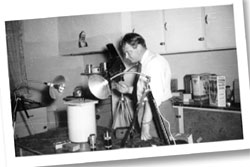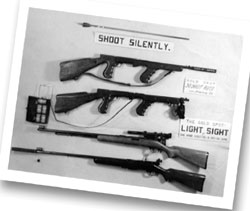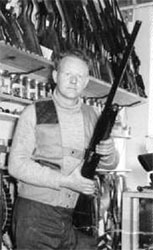Silenced forever - The GSA Silencer
by John Hunter
Australian Shooter May 2001
From accessing records of sales from 1950 onwards, it has been clarified that at least 400,000 silencers were sold throughout Australia and overseas until legislation made it an offence to have the item in your possession.
 Along with Burrsthreo oil and Field side mounts, the GSA silencer takes its place in Australian firearm industry history. Originating in Adelaide in the postwar era of surplus military rifles and fullmetal jacket ammunition, the GSA silencer has been a valued accessory to many vermin hunters throughout Australia.
Along with Burrsthreo oil and Field side mounts, the GSA silencer takes its place in Australian firearm industry history. Originating in Adelaide in the postwar era of surplus military rifles and fullmetal jacket ammunition, the GSA silencer has been a valued accessory to many vermin hunters throughout Australia.
Don Fleetwood returned from England after WWII with the desire to operate his own gun shop. A mid-upper gunner in the 460 Bomber Squadron (Lancasters), he had always been involved with firearms as a boy and the action seen during the war years fuelled that interest. In 1950 Don established The Grange Rifle Store in the Adelaide beachside suburb of Grange and he looked for other forms of income besides the surplus SMLE rifles, Martini cadet rifles and army ammunition that flooded the market.
During a wartime visit to the Parker Hale factory in England, Don purchased a silencer manufactured for .22LR rifles. That silencer became the pattern by which the GSA silencer was produced in several variants before the current style was settled upon.
The initial lot of silencer bodies were hotblued over the gas stove in the kitchen - a resulting golden flaw on one of them gave way to the name ‘GSA’ - Gold Spot Accessories.
Several length variations were experimented with before the six-inch overall length was accepted. The tube of the silencer housed a set of metal baffles, held forward of an initial expansion chamber by a crimping set in the silencer body. A nose cap was then screwed in at the muzzle end that not only kept the baffles within the tube, but compressed them pending final manual alignment.
The GSA silencer bodies and nose caps were manufactured by an engineering firm who, for the life of Don, honoured an agreement not to sell them to other sources. The internal baffles were also manufactured externally with the components being assembled in-house, resulting in a highly marketable accessory.
In 1953 Don began South Australian Sportsgoods Distributors and the sale of GSA accessories started to accelerate. Normally 300 to 400 bodies were assembled in a batch. The ‘in the white’ bodies were blued in-house after the GSA brand name was rolled on by a foot-operated manual press stored in the backyard of the shop. The oiled, blued bodies had to be wiped clean and then nine baffles were assembled on a guide rod and were coerced into the silencer tube. The nose cap was then hand tightened before final fitting using a pair of multi grips with leather-lined jaws. The desired final assembly has the nose cap just failing to seat against the body tube after the final tightening. On those rare occasions when the nose cap seated firmly and directly against the tube, oversize baffles were installed to ensure the desired result. The last task was to align the baffles within the finished article by inserting a turning 17/64" drill through the tube. Each silencer sold under the GSA name was hand assembled.
 Advertising material from The Grange Rifle Store dated August 1951 stated that “1500 satisfied customers” were using the GSA silencer - including New Zealand customers. In 1957 further advertising under the SA Sportsgoods name detailed that “6000 wily hunters use GSA rifle silencers throughout Australia...” In that year they cost 49/3d, with fitting extra. From accessing records of sales from 1950 onwards, it has been clarified that at least 400,000 silencers were sold throughout Australia and overseas until legislation made it an offence to have the item in your possession. All silencers were sold on a money-back guarantee and it is a testimony to the success of the simple design that not one was ever returned because it failed to meet expectations.
Advertising material from The Grange Rifle Store dated August 1951 stated that “1500 satisfied customers” were using the GSA silencer - including New Zealand customers. In 1957 further advertising under the SA Sportsgoods name detailed that “6000 wily hunters use GSA rifle silencers throughout Australia...” In that year they cost 49/3d, with fitting extra. From accessing records of sales from 1950 onwards, it has been clarified that at least 400,000 silencers were sold throughout Australia and overseas until legislation made it an offence to have the item in your possession. All silencers were sold on a money-back guarantee and it is a testimony to the success of the simple design that not one was ever returned because it failed to meet expectations.
Price of the GSA Silencer
1950 - 42/6d ($4.25)
1952 - 59/6d ($5.95)
1956 - 49/3d ($4.93)
1976 - $6.20
1992 - $50
Silencers were sold to government departments throughout Australia - including the National Parks Department in Queensland, which required a custom silencer for a Winchester 94 in .44/40 calibre. The South Australian Police Special Tasks and Rescue Force has GSA silenced Brno rifles for ‘special’ tasks - such as ‘turning off’ streetlights at armed-offender incidents. Brno rifles fitted with GSA silencers are being used to help control the migratory habits of the common garden starling into Western Australia.
Fitting
The GSA silencer was best fitted to most rifles by screw-cutting the end of the barrel. One customer presented his barrel for correction after ‘someone’ had used a hand die to engrave the thread on the rifle barrel. Using the standard 1/2" S.A.E x 20 t.p.i. thread, Sportsgoods’ resident gunsmith, Mr ‘Blue’ Parker, fitted tens of thousands of barrels throughout his 38-year employment with the company.
Sportco rifles were purchased in large quantities and often threaded in batches of 30, with staff assisting by stripping the action in preparation for the lathe operation. Each threaded rifle had a silencer fitted and checked for alignment. The duo was then stored pending sale. A blued steel-thread cap was supplied with every silencer at sale, which maintained the appearance of the firearm when the silencer was not attached.
Brno Model 2 rifles required the stripping of the front sight and its spring-loaded keeper before the front sight band was removed by applying heat in cautious amounts. The barrel was then thread cut, with the front sight band being trimmed back to allow access to the now threaded area of the barrel. There was a rare incident when the internal barrel diameter of a particular Brno Model 2 rifle was tight, causing an increase in velocity, which kick-started even subsonic ammunition over the speed of sound. The silencer was then unable to stop the ‘crack’ of the supersonic projectile and the rifle was replaced for the customer.
Ruger 10/22 rifle barrels had the muzzle end cut by the length of the front sight band, the diameter of the remaining barrel was turned to 1/2" for a length that would accept the thread and the re-fitted front sight band. The front sight band initially cut from the barrel was drilled out to 1/2" and sweated back onto the barrel. Rifles such as Voere and the Armalite AR7 posed problems because their barrels were steel tubes surrounded by alloy exterior. Upon threading, the outer sheath would separate from the inner steel barrel. The Erma ‘M1 carbine’ was a particularly tedious job to undertake in that the front sight tapered pinhole had to be hand filed to refit the front sight. It was important to remember that if you wished for ‘silence’ when firing your 22LR rifle with silencer attached, it was best that the barrel was ‘dirty’.
 Fitting charges
Fitting charges
1952 - 16/- ($1.60)
1993 - $50
Adaptors
Adaptors were sold in those cases where the owner did not want the barrel threaded. Contrary to what we see in the movies, the GSA adaptor was a force fit and ‘take on-take off’ ability was not available. The Miroku .22LR lever action rifle and some other popular tube feed rifles were fitted with a custom adaptor that had a relief cut for the inner magazine tube to be removed for reloading. Interesting to note that Blue used an adaptor on his Brno Model 1 rifle - insisting upon the moral high ground that Brno Model 1s were “too good to be threaded”.
1974 prices of GSA Silencer Adaptors
Slazenger single shot - $3.52
Slazenger Model 12 or 55 - $3.52
BSA - all ‘Sportsmen’ series - $3.52
Krico Repeater Model 302 only - $4.58
Brno Model 1 and 5 only - $4.58
Blank drilled and reamed for pilot hole - $3.00
Cleaning
The GSA rifle silencer did not require cleaning unless it had been used in a very wet environment. If that was the case then it was recommended that the owner rinse the complete unit in petrol or thinners, then blow dry with compressed air. Many owners were forced to buy an extra set of baffles when, after taking the assembly apart, replaced the baffles out of alignment, which resulted in the projectile colliding with them. The advice given was not to remove the nose cap unless absolutely necessary. Boys will be boys and many a silencer caused inaccuracy problems because curiosity overwhelmed good advice.
Other ‘barrel’ items
SA Sportsgoods Distributors manufactured,on a limited basis, other barrel attachments, which did not meet the sales volume of the GSA silencer. A ‘blast deflector’ was manufactured using the same tube as the silencer. The tube, however, had longitudinal slots cut in it to allow escape of gas. The nose cap had a central tube attached to it, which entered the body tube. That tube also had angular slots cut into it for dispersion of gas. The entire unit was the same size as the silencer and was marketed for use of centrefire rifles of .22 calibre - specifically the Ruger Mini 14 series. The barrel was threaded the same as for silencers and the unit was also secured to the barrel by the use of a lock nut. These units were advertised nationally, but did not sell well.
Markings
Most GSA silencers were roll stamped with the GSA logo and the words ‘Gold Spot Silencer Made in Australia’ and ‘Use only Standard Velocity Cartridges’. When pending legislation attempted to ban the manufacture and possession of silencers, Don Fleetwood changed the wording on the tubes to read ‘Sound Muffler .22RF 1000f/s Non-Silencer’ and ‘Stop Noise Pollution Made in Australia’.
The GSA .22 Rifle Silencer remains an icon of a previous time in our Australian-shooting calendar - a time when firearms and their accessories were of little consequence to lawmakers. The firearms and the accessories have not changed, but sadly society has. The lawmakers need to focus upon the causes of violence and not the tools. Sadly for the owners of some 400,000 GSA silencers who have surrendered them, that was not the easy option.
Note: Possession of silencers is restricted in all states.
